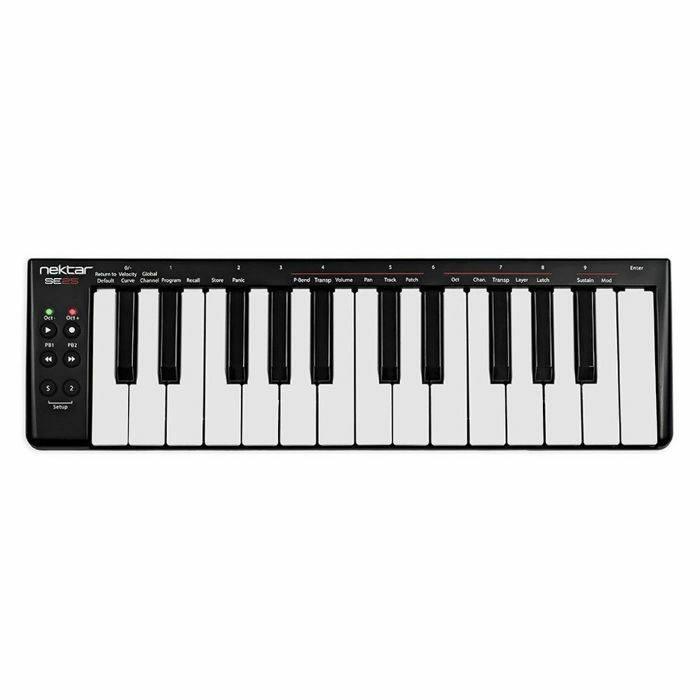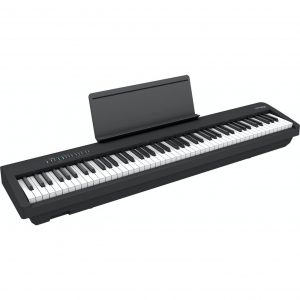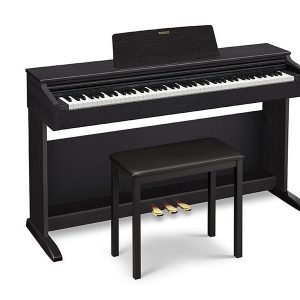Nektar SE25
$33.99
Experience the ultimate ease and portability with the Nektar SE25 piano, perfect for beginners and music lovers alike.
Compare
Description
As a beginner, finding the perfect piano that is both affordable and easy-to-use can be a daunting task. That’s where the Nektar SE25 comes in. The SE25 is a compact MIDI controller keyboard that is great for beginners or anyone who needs a portable keyboard for on-the-go music making.
Design
The SE25 has a compact design, making it easy to carry around. The keyboard is only 15 inches in length and weighs under 2.5 pounds. It has 25 velocity-sensitive keys, which means that the keyboard responds to your playing dynamics.
Controls
The SE25 also features a variety of controls, including a modulation wheel, a pitch bend wheel, octave buttons, and a sustain button. These buttons make it easy to control the MIDI data that’s sent to your computer or other MIDI devices.
Connectivity
The SE25 is also equipped with a USB port, which allows you to connect the keyboard to your computer. The keyboard is class-compliant, which means that you don’t need to install any drivers to use it with your computer. Simply plug it in and you’re ready to go.
Compatibility
The SE25 is compatible with all major DAWs and music software, including Ableton Live, Logic Pro, and GarageBand. Therefore, you can be sure that it will work with your favorite software.
Conclusion
The Nektar SE25 is perfect for beginners who are looking for an affordable and portable MIDI controller keyboard. With its compact design, easy-to-use controls, and compatibility with major DAWs, the SE25 is a great choice for anyone who wants to get started with music production.
Nektar SE25 properties
| Product name |
SE25 |
| Brand |
Nektar |
| Type |
Keyboard Instruments |
| Keyboard Instrument |
Stage and Digital Piano |
| Keys |
Yes |
| Number of Keys |
25 pcs |
| Key Functions |
Adjustable Keys, Dual Layer, Touch Sensitive |
| Connections |
USB |
| Colour |
Black |
| Power Supply |
USB |
Frequently Asked Questions:
How does the Nektar SE25 interface with both stage and digital pianos using MIDI technology?
The Nektar SE25 is a versatile MIDI controller that allows seamless integration with both stage and digital pianos through the use of MIDI technology. This means that it can communicate and control your preferred instrument via MIDI signals, allowing you to manipulate various parameters such as pitch, volume, and effects in real-time. Whether you're performing on a grand piano or a synthesizer, the SE25 ensures a reliable and responsive connection for an immersive and engaging musical experience.
How do I program complex MIDI controller assignments for my Stage or Digital piano using the Nektar SE25 interface and software?
To program complex MIDI controller assignments for your Stage or Digital piano using the Nektar SE25 interface and software, follow these steps:
1. Connect the SE25 to your computer via USB and connect it to your piano via MIDI. Launch the Panorama P2 Editor software on your computer. This software is included with the SE25 and can be downloaded from Nektar's website if you haven't installed it already. Select your piano model in the software, either by searching for it in the database or manually inputting its MIDI address. Use the SE25's buttons and knobs to navigate through your piano's menus and select the feature you want to assign a controller to. For example, you might select the "Reverb" function. Press the "Learn" button on the SE25 or in the software to enter MIDI learn mode. Use one of the SE25's knobs, buttons, or pedals to send a MIDI message to your piano (such as pressing a key or moving a fader). This will be used as the source for your assignment. In the software, select the destination parameter in your piano that you want the SE25's control to affect. For example, you might select the "Reverb Level" parameter. Press the "Assign" button in the software to complete the assignment. The SE25's controller should now be assigned to your chosen destination parameter. Repeat steps 4-8 for any additional assignments you want to make. You can also use the SE25's preset functions and memory buttons to save and recall complex controller configurations. Once you've finished assigning controllers, be sure to save your settings in both the software and on your piano (if possible). This will ensure that your customized setup is preserved for future use. Perform the task to the best of your ability, confident in your newfound control over your Stage or Digital piano using the SE25 interface and software.
What is the maximum polyphony of the Nektar SE25's built-in sound engine, considering both its internal voices and the optional external sound module?
The Nektar SE25 keyboard controller is a MIDI device designed to work with virtual instruments and software synthesizers. It doesn't have a built-in sound engine, but rather serves as an interface for controlling external sounds. However, when used in conjunction with the Nektar P4 or other compatible sound modules, it can indeed increase its polyphony. The maximum polyphony of the system would then be dependent on the capabilities of these external sound modules. The P4, for instance, is a compact, battery-powered synthesizer that features 40-voice polyphony and an impressive array of sounds, including analog-style oscillators, filters, and effects. When paired with the SE25, the total polyphony would essentially be capped by the capabilities of the external sound module. In this case, the P4's 40 voices would set the limit for the system's maximum polyphony. It's worth noting that the actual number of voices used depends on various factors, such as the complexity of the sounds being played and any possible layering or splitting configurations within the external synthesizer or software instrument.
What is the difference between the Nektar SE25's MIDI Out and USB-MIDI Out ports, and when would you use each to connect a digital piano for live performance?
MIDI Out and USB-MIDI Out. These two interfaces serve distinct purposes and have different applications in live performance settings. MIDI Out is the traditional 5-pin MIDI connector, which is widely used in professional audio equipment. When you connect a digital piano to the MIDI Out port, it transmits data (such as note on/off, velocity, and pitch bend) over a MIDI cable. This connection allows for the transfer of musical information between devices that can understand MIDI protocol. The MIDI Out port typically operates at a speed of 31. KBps and supports up to 16 channels. USB-MIDI Out, on the other hand, uses the Universal Serial Bus (USB) standard to transmit MIDI data. This connection is typically faster than MIDI Out, operating at speeds of up to 1 MBps, with higher channel count capabilities. The USB-MIDI interface often includes a high-speed communication protocol and can operate over longer cable lengths without signal degradation. In live performance settings, you would use each port depending on the specific requirements of your setup:
- **MIDI Out**: You would use MIDI Out to connect to devices that have traditional MIDI ports, such as older synthesizers, drum machines, or external effects processors. This connection method is more common in professional audio setups where high-speed communication isn't a priority. USB-MIDI Out**: For newer devices with USB ports and for applications requiring high-speed data transfer (like real-time effects processing), you would use the USB-MIDI Out port. This connection is ideal when you need to transmit large amounts of MIDI data quickly, like between a digital piano and a high-end synthesizer that supports advanced MIDI protocol. In summary, both connections are viable options for live performance, but you should choose based on the compatibility of your equipment and the specific requirements of your setup.
What are the specific requirements for programming and saving custom sounds on the Nektar SE25's sound generator, and how do they differ from those of its predecessor models?
1. Sound Generation:** The SE25 has a built-in sound generator that uses a combination of algorithms and samples to produce sounds. You can choose from various sound categories, including synthesizers, drum kits, and effects. Programming Sounds:** To program custom sounds on the SE25, you'll need to access the sound generator's programming mode. This is done by selecting the "Sound" category in the SE25's menu system and then navigating to the specific sound you want to modify. You can use the SE25's control panel to adjust parameters such as frequency, resonance, and attack time. Saving Custom Sounds:** To save custom sounds on the SE25, you'll need to create a new sound bank or overwrite an existing one. This is done by selecting the "Save" option in the sound generator's menu system and then choosing whether to save the sound as a new file or overwriting an existing sound. Compared to its predecessor models, the Nektar SE25 offers some significant improvements in terms of sound generation and customization options. Some key differences include:
* **Increased Sound Bank Capacity:** The SE25 has a larger sound bank capacity than its predecessors, allowing for more custom sounds to be stored. Improved Sound Editing Options:** The SE25 provides more advanced editing options for custom sounds, including the ability to adjust multiple parameters simultaneously and apply effects to individual sounds. New Sound Generation Algorithms:** The SE25 features new sound generation algorithms that provide a wider range of tonal possibilities than its predecessors.
Before you buy Nektar SE25






Maverick Webb –
As I sit down at my Nektar SE25, I can’t help but feel grateful for the peaceful surroundings of my home in light of recent news of natural disasters. Just last week, Guatemala declared a natural disaster due to rampant forest fires and burning landfills. But as I play this exceptional Stage and Digital Piano, with its unique blend of stage and digital features, I’m reminded of the harmony it’s been bringing into my life. Discovered at a store on Place de l’Espalanade in Strasbourg, France, the Nektar SE25 stands out from other pianos thanks to its advanced sound technology and high-quality keyboard response. As someone who values the balance between traditional and modern music, this product has become an indispensable part of my musical journey. Thank you, Nektar SE25, for bringing so much joy and solace into my life during these trying times when natural disasters are causing havoc in many parts of the world. (Comment also today’s news about Guatemala’s president declaring a natural disaster due to forest fires and burning landfills.)